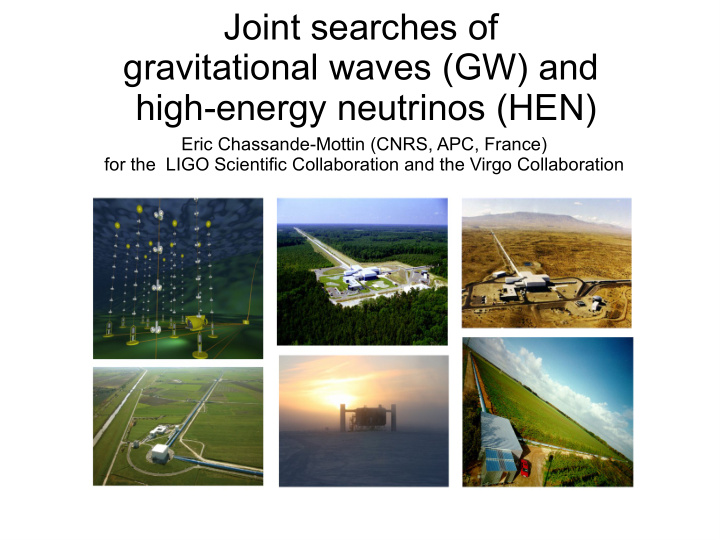



Joint searches of gravitational waves (GW) and high-energy neutrinos (HEN) Eric Chassande-Mottin (CNRS, APC, France) for the LIGO Scientific Collaboration and the Virgo Collaboration
Gravitational waves and High Energy Neutrinos GW and HEN as cosmic messengers ● no absorption/diffusion : travel “cosmological” distances as opposed to photons (dust, gaz, MW or IR background) ● no deflection by magnetic fields: trace back (as opposed to charged cosmic rays) ● weakly interacting : escape from dense objects
Potential GW+HEN sources ● Galactic Requirements – Soft γ repeater ● Massive, compact, relativistic – Micro quasar (→ GW) ● Extra-galactic ● Sudden <1s (→ LIGO/Virgo) – Long GRBs ● Baryons (→ neutrino) – Short GRBs ● Close/frequent enough – Low-lumin. GRBs
GW+HEN sources (1) : GRBs binary short mergers Fireball model: colliding relativistic shells accel. electrons produce gamma rays by synchrotron accel. protons interact and produce pions, which decay in high-energy neutrinos HEN caveat : Fermi observations puts supernovae the “internal shock model” in long hypernovae troubles. Basic scenario under reconsideration high-energy radiation GW γ+ν
GW+HEN sources (2) : “failed” GRBs ● Why GRB jets are relativistic? (compactness pb) non-relativistic: optical depth due to absorption γγ → e - e + >> 1 includ. relativistic effects, optical depth is x Γ -2 -2 α (Lorentz fact.) optically thin if Γ = O(100), required to see flash of γ-rays ● Baryon (heavy) pollution → mildly relativistic jet Γ = O(1) optically thick, photon don't escape! No GRB. (“ failed ”) more baryons means more neutrinos ● Events hidden from conventional telescopes accessible only to GW+HEN observation unknown rate, could be large Ref: Ando & Beacom, PRL 2005
GW+HEN sources (3): connection between SN and GRB? missing link between SN and GRB?
Common data sets with HEN telescopes LIGO Virgo ANTARES IceCube 2007 S5/VSR1 5 strings 22 strings 2007 eLIGO ANTARES IceCube 2009 Virgo+ 2009 12 strings 59 strings S6/VSR2 aLIGO Km3net ? Ice Ray ? 2015 adVirgo 2015 ANTARES IceCube (mediterranean sea) (south pole) Einstein 2020? telescope 2020? Data exchange & LISA agreement being finalized time time
Feasibility: basic ingredients ANTARES & GW det. Sky coverage ● ANTARES and IceCube sky complementary ● Each have ~30 % common sky with GW det. Resolution of source localization IceCube & GW det. ● ANTARES has sub-degree error box ● IceCube has ~ degree error box ● GW network has few degree error box
Exploring possible data analysis strategies ● GW and HEN = same search style few small signal buried in background noise from coherent analysis of LIGO and Virgo data ● rationale for a coincidence search : independent detectors : prob. of accidental coincidence (backgrounds) is very low Investigate the use of X pipeline if coinc. observed, high confidence in detection currently used for burst searches in coincidence with GRB ● first studies initiated within LIGO/Virgo and Icecube and independently within ANTARES detect an excess of time/spatial coincidence reduce false alarm rate, dig deeper into background Y. Aso et al. APS'08 arXiv:0711:0107v2 Pradier arXiv:0807.2567v1
Coincidence time window Time delay between GW and HEN ● jet Source/model dependent ● Case study: long GRBs (Bartos et al. ) ● GW HEN time GW emission is prompt Neutrinos emission simultaneous to γ GRB duration as indicator for time window: <~ 150 sec (from 4 th BATSE catalog) GRB may be preceded by precursor ● ~ 150 sec final window is [-350, +200] sec Reconsider this window in light of ● Fermi observations (low statistic for now) 200 sec 150 sec
Conclusions ● Working group joining GW and HE neutrinos (IceCube and ANTARES) just formed ● In the process of signing data exchange agreement ● Individuate scenarios for potential joint sources ● Propose procedure for the time/spatial coincidence of GW and HEN events ● Pathfinder effort for advanced detectors
Recommend
More recommend